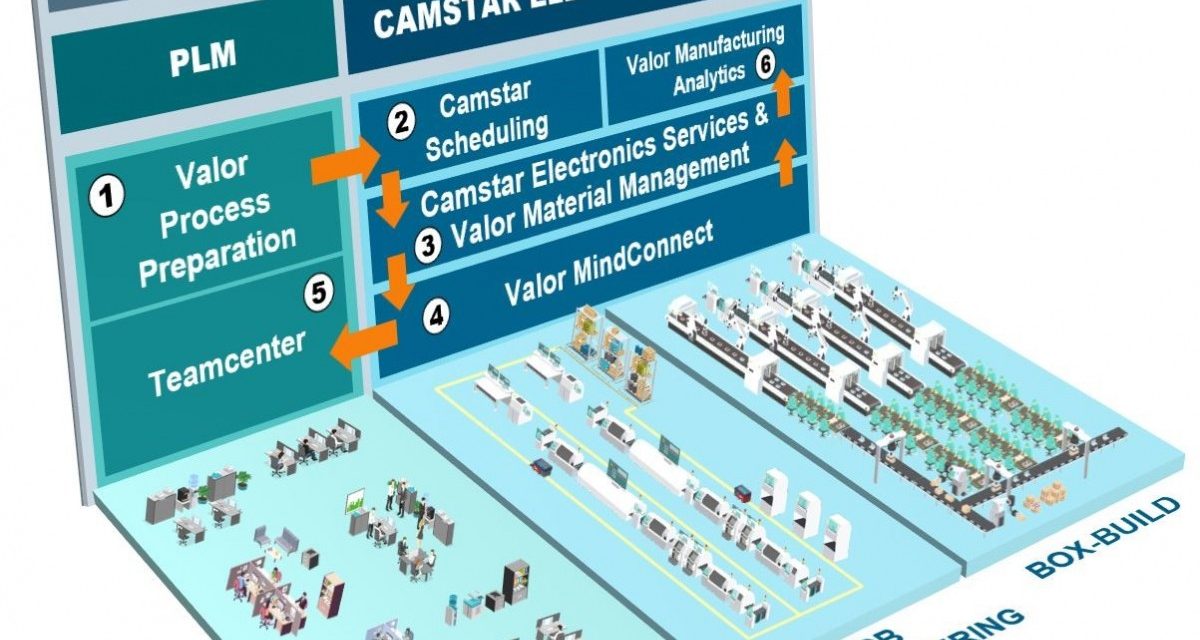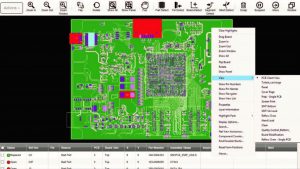A Step Forward Together: New Innovative Collaborations Designed for PCB Manufacturing

By Fram Akiki, Vice President, Electronics & Semiconductor Industry, Siemens PLM Software
 If you are an electronics manufacturer, you are probably looking for ways to address rising costs, operational inefficiencies, and shortened product release cycles. The need for better operational efficiency stands out as a major business pressure, according to a recent survey of electronics manufacturers conducted this year (The Role of MES for Smart Manufacturing in Electronics, Aberdeen, 2019). Forty-five percent of respondents said that operating costs are too high, and 64% cited the pressure of needing to reduce costs. Thirty-seven percent said they are challenged by reduced budgets (operational or capital), and 36% said they are dealing with issues of product quality levels. The need to comply with current and future regulations was cited by 27% of respondents.
If you are an electronics manufacturer, you are probably looking for ways to address rising costs, operational inefficiencies, and shortened product release cycles. The need for better operational efficiency stands out as a major business pressure, according to a recent survey of electronics manufacturers conducted this year (The Role of MES for Smart Manufacturing in Electronics, Aberdeen, 2019). Forty-five percent of respondents said that operating costs are too high, and 64% cited the pressure of needing to reduce costs. Thirty-seven percent said they are challenged by reduced budgets (operational or capital), and 36% said they are dealing with issues of product quality levels. The need to comply with current and future regulations was cited by 27% of respondents.
Smart manufacturing means to eliminate physical prototypes, disconnected systems, paper-based work instructions, and silos of information, enabling a continuous, integrated flow from design to planning to production. Today’s electronics manufacturers need to adopt a smart manufacturing methodology that provides a fully integrated digital thread, from design through manufacturing.
The difference between this smart manufacturing approach, which generates and distributes accurate, validated product and process models across the factory or multiple factories, and current piece-meal digitalization strategies, is visibility at every stage of product development. Some key differences include:
- More reliable and manufacturable designs
- Better collaboration among design, engineering, and manufacturing departments
- Less data redundancy
- Fewer shop-floor planning mistakes
- Less error-prone manual data entry
- Optimized inventory and just-in-time use of materials
- Enforced manufacturing best practices
- Accurate and up-to-date work instructions
- Plug-and-play data collection and key performance indicators (KPI) monitoring
- Fast time to root-cause identification
- Transition toward higher product mix without loss of factory performance.
A smart manufacturing flow connects design engineering to verification to production execution to product end-use in a continual, real-time, closed feedback loop. In a smart factory, manufacturers realize greater efficiencies by merging the real and virtual product using digital twins, models that represent the design, manufacturing, and operation in real-time, which enables entirely new levels of product innovation (as well as manufacturing efficiency and effectiveness), while eliminating risk and maximizing performance. The Internet of Things, or edge, devices are integral to connect operations in smart factories; they allow machines to gather data and monitor the production process throughout a plant.
In this digitally connected environment, the requirements for manufacturing execution systems software have changed. Electronics manufacturers need high-performance software so they can be flexible and agile. They need consistent, normalized data across all phases of the manufacturing flow (design, virtual commissioning, design for manufacturability, process engineering, and production execution). This holistically digitalized manufacturing environment demands scalable, end-to-end, enterprise-level tools that can grow with the business.
Modern manufacturing operations management (MOM) and end-to-end manufacturing execution systems (MES) can help meet these challenges. As Industry 4.0 ushers in the Internet of Things, the Cloud, and big data analytics, MOM and MES can leverage this new influx of data, make sense of it, and drive greater value across production, quality, and compliance. These software solutions can provide end-to-end, real-time process visibility and traceability, along with the ability to manage, monitor, synchronize, and optimize physical production processes. These types of systems are integral to “smart” manufacturing.
Today, Siemens provides a comprehensive MOM solution for electronic and mechanical preproduction, production, and execution. The solutions manage data from all resources (tools, operators, machines), provide complete as-built traceability, and integrate seamlessly with enterprise resource planning (ERP) and product lifecycle management (PLM) systems. And, smart manufacturing for electronics is supported by a number of Siemens PLM Software product suites, including Teamcenter, Active Workspace for Teamcenter software, NX™ software, Teamcenter Manufacturing, the Tecnomatix® portfolio, CAMSTAR™ BoxBuild software, Preactor software, Valor™ Material Management software, Valor Process Preparation software, Valor IoT software, and Valor Manufacturing Analytics software.
Engineers at Siemens and Mentor working together saw that, for today’s technology manufacturers, an end-to-end MES should support both electronics (PCB) and mechanical (box build) production. An effective solution should be able to be deeply integrated with PLM, ERP, and other MOMs. It needed to be comprehensive, yet customizable and flexible. Integration with production-optimization scheduling software also is critical. They wanted an MES that would support IoT-based, real-time, sensor data collection from the shop floor, transform it into actionable insights, and generate closed-loop feedback to design and process engineering using real-time production analytics.
To this end, engineers working on Siemens CAMSTAR MES and Valor Manufacturing software created a new solution for the “smart” manufacturing of PCBs and electronic systems. And to their credit, Siemens announced the release of the CAMSTAR Electronics Suite at IPC APEX, an innovative MES made specifically for electronics manufacturers. Building on CAMSTAR, which is an established and reliable enterprise-level platform for integrated circuit manufacturing, the new MES solution is configurable and scalable to enable PCB and box assemblers to meet traceability requirements, improve efficiency levels, and control manufacturing operations through direct IoT connectivity with machines and production lines.
 The new MES integrates Valor’s tried-and-true manufacturing execution tools for materials management, traceability, planning and process preparation as well as big-data analytics. The goal is for electronics manufacturers to be able to shorten product lifecycles, increase production complexities, improve quality across the entire manufacturing lifecycle, and enable quick reactions to design modifications by closing the loop between engineering and the shop floor.
The new MES integrates Valor’s tried-and-true manufacturing execution tools for materials management, traceability, planning and process preparation as well as big-data analytics. The goal is for electronics manufacturers to be able to shorten product lifecycles, increase production complexities, improve quality across the entire manufacturing lifecycle, and enable quick reactions to design modifications by closing the loop between engineering and the shop floor.
CAMSTAR Electronics Suite makes the flow of product and business data between PLM, ERP, and shop-floor execution seamless through an integrated digital thread, enabling faster and streamlined change cycles. This development is just one of many more steps that the Siemens PLM Software division is taking to grow its digital innovation solutions. The collaboration between Siemens and Mentor engineers has resulted in this unique solution. They achieved their goal to provide a single data source, closed-loop feedback from production to design and engineering departments that should enable improved quality levels and shorter new product introduction processes and go-to-market times for electronics manufacturers.
When Siemens closed the acquisition of Mentor Graphics in 2017, management at both companies saw that as the number of products with electronics content continues to grow, the concept of the digital enterprise would not be complete without tools specific to electronics design and manufacturing. Since then, Siemens engineers have spent a lot of time and applying their expertise to figuring out how best to help our customers integrate the flows of electronic and mechanical product development. At Siemens PLM, we are working on how best to integrate our solutions so our customers can take an idea and turn it into a product as accurately, quickly, and cost-effectively as possible. And, we’re putting our “money where our mouth is”; putting these solutions to work in transforming our own advanced operational factories to smart manufacturing as early adopters.
“The CAMSTAR Electronics Suite introduces a layer of value that we could never reach with our existing set of disconnected tools, even with custom integration. The inclusion of Valor IoT data acquisition in the suite has drastically simplified the deployment across our assembly lines,” said Hermann Kraus, MES project lead at the Siemens Fürth factory. “We have already taken the first step of implementation, optimizing material flow with Valor Material Management. We are currently introducing the second step that will deliver a true one-stop-shop solution, covering all process areas and integrated with PLM and ERP.”
In future articles, we will look at the Siemens factory in Fürth, Germany, to see how this digital transformation is realized.
About the author
Fram Akiki is Vice President, Electronics & Semiconductor Industry for Siemens PLM Software. He has over 30 years of experience in the electronics and semiconductor industry. Prior to joining Siemens, Fram was an executive for 12 years with Qualcomm in their chipset division and 21 years with IBM in their microelectronics group. Fram holds a B.S. in Electrical and Computer Engineering from Clarkson University and a M.S. in Electrical Engineering and a M.B.A. in International Business from The University of Vermont. He has authored a number of white papers, holds a patent on RFID/Cellular connectivity for the IoT market and is an adjunct instructor at Clarkson University.
.











